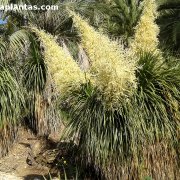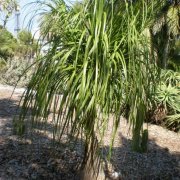Care of the tree Beaucarnea recurvata or Nolina recurvata |
|
The genus Beaucarnea, family Asparagaceae, comprises 15 species of trees native to Mexico and Central America. Some species are: Beaucarnea recurvata, Beaucarnea hiriartiae, Beaucarnea gracilis, Beaucarnea goldmanii, Beaucarnea beldingii, Beaucarnea guatemalensis. Common names: Elephant's foot, Ponytail palm. Scientific synonym: Nolina recurvata. This species is native to Oaxaca, Puebla, San Luis Potosí, Tamaulipas and Veracruz, Mexico. They are little branched trees with a thick base trunk (to store water) and that reach 10 meters (32.8 feet) high in their environment; in pots they reach 1.5 meters (4.9 feet) in height. They have thin, long, curved, green leaves. The small cream-white flowers appear in panicles in spring; they bloom after 10 years of life. Elephant's foot is used as a houseplant, greenhouse and terrace. In regions without frost it's used as isolated specimens or in small groups. Nolina recurvata needs a full sun exposure or a very bright one (indoors). It's ideal for heated rooms. It resists occasional frosts down to -5 ºC (23 ºF). The soil can be a mixture of garden substrate with 40-50% coarse sand. It is important to grow them in flat pots so that water does not accumulate. Water very moderately, waiting for the substrate to dry completely. They are very resistant to drought plants. In winter, water only once a month. Beaucarnea recurvata does not need pruning or fertilizers. The main enemies are overwatering (it rots the roots) and mealybugs (excess moisture). Due to its great slowness of growth, it is advisable to buy new plants in garden centers or nurseries. |
Images of the tree Beaucarnea recurvata or Nolina recurvata |
Find plants
Beaucarnea recurvata or Nolina recurvata | Care and Growing
© 2025 FavThemes










